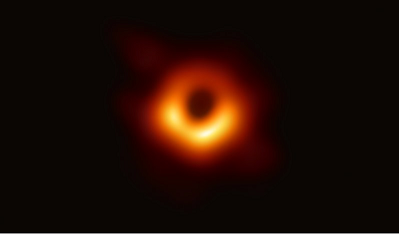
The first direct visual evidence of the supermassive black hole in the centre of the galaxy Messier 87 has been observed by the Event Horizon Telescope -- a planet-scale array of eight ground-based radio telescopes.
NEW DELHI (PTI): Indian scientists have hailed the compilation of the first ever real images of a blackhole as an "extraordinary feat" that sheds more light on the mysterious, warped region of the space-time fabric and how galaxies like our Milky Way evolve over time.
Blackhole, an object with such strong gravity that not even light can escape it, has fuelled human imagination and inspired numerous sci-fi movies and literature for generations.
In coordinated press conferences on Wednesday across the globe, researchers at The Event Horizon Telescope (EHT) – a planet-scale array of eight ground-based radio telescopes forged through international collaboration – unveiled the first direct visual evidence of a supermassive blackhole and its shadow.
The image reveals the black hole at the centre of Messier 87, a massive galaxy in the nearby Virgo galaxy cluster.
This black hole resides 55 million light-years from Earth and has a mass 6.5 billion times that of the Sun.
"We have taken the first picture of a black hole," EHT project director Sheperd S Doeleman of the Centre for Astrophysics at Harvard & Smithsonian announced.
"This is an extraordinary scientific feat accomplished by a team of more than 200 researchers, Doeleman said.
Several Indian physicists spoke about the significance and history made by the discovery.
"This is the first direct evidence of black hole. That way it is a game changer. Now there is no doubt at all about its existence. Earlier we had 99 per cent evidence, now it is hundred per cent," said Sudip Bhattacharyya, Associate Professor at Tata Institute of Fundamental Research (TIFR), Mumbai.
"If we can directly see that there is something black in the background of light -- that is an incredible thing. That would be the direct proof of blackholes," Bhattacharyya told PTI.
The breakthrough was announced in a series of six papers published in a special issue of The Astrophysical Journal Letters.
"The unveiling of M87 shadow is a tremendous achievement by EHT and it provided first independent estimate for the mass of the giant blackhole in M87," Achamveedu Gopakumar, an associate professor at TIFR told PTI.
"These results showed that the first direct observational proof (photo) of the event horizon and its size is comparable to the size of the solar system," said Gopakumar, who is a part of EHT's effort to image a massive black hole binary (candidate) emitting nano-Hertz gravitational waves, called OJ 287.
The EHT is the result of years of international collaboration, and offers scientists a new way to study the most extreme objects in the universe predicted by Albert Einstein's general relativity during the centennial year of the historic experiment that first confirmed the theory.
"Seeing is believing, and this is, by far, the most direct proof that black holes exist," said Poshak Gandhi, an Associate Professor at the UK-based University of Southampton's Astronomy Group.
"The results by the Event Horizon Telescope (EHT) team also represent years of truly global cooperation," said Gandhi, who originally hails from New Delhi.
Black holes are extraordinary cosmic objects with enormous masses but extremely compact sizes.
The presence of these objects affects their environment in extreme ways, warping spacetime and super-heating any surrounding material.
"These are a class of supermassive blackholes that have a billion times the mass of the Sun," said theoretical physicist Rajesh Gopakumar, Director of the International Centre for Theoretical Sciences (ICTS-TIFR), Bangaluru.
"It is a very remarkable breakthrough because one has had indirect confirmation for a long time about blackholes, but this is a different category of blackholes which are so much more massive," Gopakumar said.
"These had always been guessed as there was indirect evidence but this the first time we can sharply see matter around it, how that is behaving and so on. These central powerhouse of the galaxies will tell us how the galaxies like our Milky Way will evolve over a long time," he said.
Multiple calibration and imaging methods have revealed a ring-like structure with a dark central region – the blackhole's shadow – that persisted over multiple independent EHT observations.
"Going forward, new data should allow astronomers to test Einstein's relativity theory in great detail, to understand how plasma accretes onto, and is ejected from, black hole environments at speeds close to that of light," Gandhi added.
 Previous Article
Previous Article Next Article
Next Article












The Indian Air Force, in its flight trials evaluation report submitted before the Defence Ministry l..
view articleAn insight into the Medium Multi-Role Combat Aircraft competition...
view articleSky enthusiasts can now spot the International Space Station (ISS) commanded by Indian-American astr..
view article